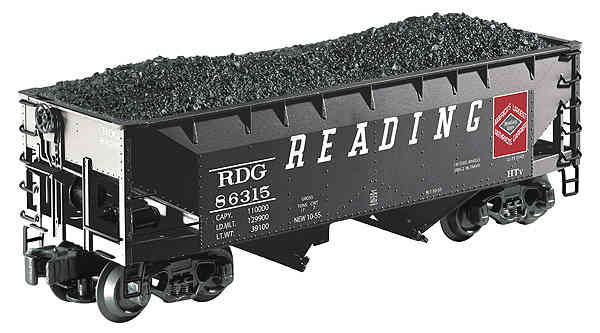The O Scale Freight Car Guide continues with an overview of 50 and 55 ton 2 bay open hopper cars. Tens of thousands of these cars were built in the first half of the 20th century and many lasted well into the diesel era and were pulled by all sorts of locomotives from 0-6-0s to mallets to modern six axle road switchers. Since the prototypes were generally 30 to 36 feet long these O scale models are appealing to operators with traditional O gauge layouts as well as those of us with O-72+ three rail scale model railroads.
All of the cars shown here were designed with enough volume to allow loading them with coal to maximum weight capacity. They were used to haul anthracite for home heating, steam coal for power plants and factories and metallurgical coal for steel making. While coal was the primary product carried in these hoppers they were used for other products if a back haul was available. If a higher density material like rock or iron ore was carried the cars could not be loaded to full volume. Some railroads used 2 bay hoppers to haul coal from eastern mines to the great lakes. After unloading, the coal the hoppers could then be loaded to maximum weight (but only partially full by volume) with iron ore for shipment to inland steel mills. At ports like Duluth, lake boats would unload eastern coal for rail shipment to western markets before taking on their next load of iron ore.
Lets take a look at the O scale models of two bay open hoppers that have been produced in recent years and can be found on the market today. We will group them by type of construction, begin with the oldest design and moving to the later style cars.
Rib Side Two Bay Hoppers
Many modelers are familiar with the single and double sheathed wood side box cars produced during World War I for the United States Railway Administration. The USRA also adopted a standardized all steel 55 ton hopper design that was produced in great numbers. It featured flat side sheets and seven external ribs. The design remained popular with railroads and car builders well into the 1920s. Our O scale train manufacturers have created several models based on the USRA hopper and a later rib side cars.
Atlas introduced their model of the USRA hopper in 2004. It is based on the tooling used by Intermountain and has been improved with a diecast frame and metal detail parts. It features operating hopper doors.

Several railroads rebuilt their USRA hoppers in the 1930s and used distinctive side panels to increase volume. Atlas began offering their panel side hopper in 2008.

The K-Line 6253 and 6254 hoppers feature a diecast body with 7 ribs and spring loaded operating hopper doors with flat or peaked ends.
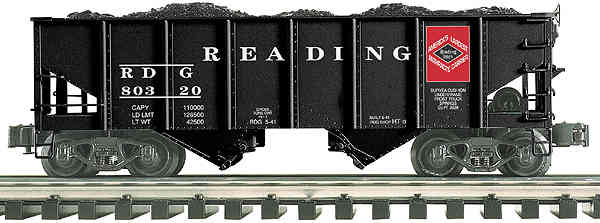
Weaver makes a hopper featuring 9 side ribs.

Offset Side Hoppers
Hoppers with offset sides have internal vertical ribs. By offsetting the side sheets to the outside the internal volume is increased over that of an outside ribbed car of equal overall length and width.
The K-Line 6251 offset side hopper features flat ends and the 6252 has peaked ends. They feature diecast bodies and operating hopper doors.
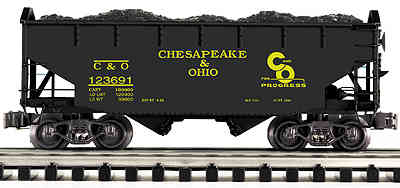
The Lionel offset side hopper has a diecast body and underframe and operating hopper doors. Flat end versions are most common although peaked and notched end versions of this hopper have also been produced.

MTH introduced their offset side 2 bay hopper in the 1999 Volume 2 catalog. It has since received improved trucks, couplers and details.

Weaver offers their two bay offset side hopper in an undecorated version as well as several road names with optional factory weathering.

Fish Belly Hoppers
Fish belly hoppers have side sills that become deeper in the middle of the car and were introduced in the 1930s.
Atlas began offering their diecast model of the fishbelly style hopper in 2001 with flat or peaked ends.

MTH introduced their fish belly hopper model in their 2007 Volume 1 catalog.

Composite Hoppers
All steel construction became the norm for hopper cars in the early 20th century. Even when many railroads were still ordering wooden box cars all steel hoppers were the norm due to the rugged service conditions experienced by hoppers. However, composite hoppers with wood sides were constructed during WW II to save steel. Some of these cars were rebuilt with steel sides after the war. Several models are available to depict original composite cars or post war rebuilds.
Atlas introduced their composite hopper in 2003.

Atlas followed up later that year with a model of a rebuilt car. Both feature operating hopper doors.

The K-Line 6255 was available in both wood...
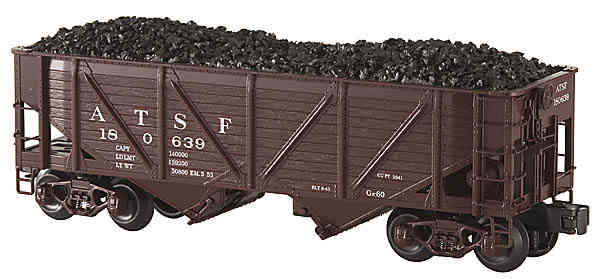
and rebuilt versions.
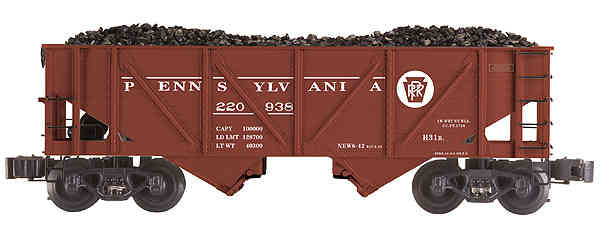
MTH first offered their composite hopper model in the 2004 Volume 2 catalog.

Weaver's composite hopper model rounds out this installment of the O Scale Freight Car Guide.

As always, corrections or additions are most welcome as are photos of your favorite 2 bay hoppers. Stay tuned for further installments including a look at 3 and 4 bay 70 and 100 ton open hoppers.
For information on other types of freight cars see the O Scale Freight Car Guide thread here.
https://ogrforum.com/t...le-freight-car-guide




